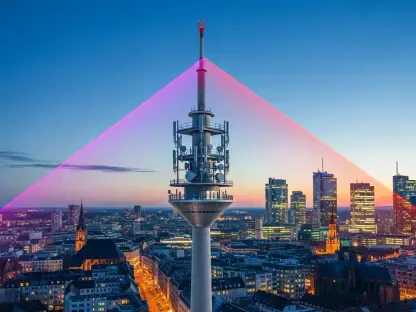In an increasingly connected world, the intersection of advanced technologies and cyber threats has reached a critical juncture, forcing stakeholders to rethink their strategies. Nokia’s latest Threat Intelligence Report reveals alarming trends in cyberattacks, emphasizing the growing roles of Generative AI and Internet of Things (IoT) devices in this evolving landscape. Over the past year, these innovations have been exploited to orchestrate a variety of cyber threats, marking a significant shift in the speed, volume, and complexity of attacks on telecommunications infrastructure. With cybercriminals adopting more sophisticated tools, the cybersecurity landscape has become perilously intricate, mandating urgent and comprehensive countermeasures.
The Rise of DDoS Attacks
Distributed Denial of Service (DDoS) attacks have seen an exponential increase, overwhelming telecom networks with excessive traffic and disrupting services. Previously rare, many networks now experience over 100 such attacks daily. This dramatic rise is largely attributed to the proliferation of botnets, which accounted for about 60% of monitored DDoS traffic from June 2023 to June 2024. These botnets often utilize residential proxies for sophisticated application-layer attacks, making them harder to detect and mitigate. Telecom networks, especially in North America, are primary targets due to their dense infrastructure and the presence of large enterprises. The relentless onslaught of DDoS attacks not only hampers service providers but also poses significant risks to businesses reliant on these networks. This surge indicates a clear trend towards more frequent and complex cyberattacks, driven by increasingly sophisticated tools and techniques.
The targeted nature of these DDoS attacks reveals the critical pressure points within the telecom industry. As DDoS techniques evolve, so too must the strategies for counteracting them. Telecommunication service providers are facing unparalleled challenges in maintaining the integrity and availability of their networks. The sophistication of Generative AI has enabled attackers to launch these campaigns with unprecedented precision, making traditional mitigation strategies obsolete. Compounding this problem is the fact that many attacks now leverage residential internet connections, making detection much harder. As businesses continue to grow dependent on digital infrastructure, the need for innovative and effective defense mechanisms becomes ever more paramount.
Geographical Distribution and Specific Threats
North America remains the most targeted region for cyberattacks, constituting about one-third of all incidents. This high frequency is largely due to dense telecom infrastructure and the concentration of large enterprises, particularly in the United States. Meanwhile, East Asia and Western Europe also face substantial cyber threats, though these vary by region. East Asia often contends with significant data leaks, frequently due to inadvertent exposures by companies. These data breaches can be particularly damaging, involving sensitive customer information and intellectual property that can be leveraged for further attacks. In an interconnected business environment, the ripple effects of such breaches can be felt globally, affecting not just direct victims but also partners and clients.
In Western Europe, the threat landscape is more diverse, encompassing cyber espionage and financially motivated breaches. These regions highlight the varied nature of cyber threats and the unique challenges they pose. The differences in threat profiles necessitate tailored security measures to effectively combat these diverse and evolving risks. For instance, while North American enterprises may need to focus on bolstering telecom infrastructure against overwhelming DDoS attacks, East Asian companies might prioritize securing data storage and implementing stricter access controls. Western Europe’s high incidence of cyber espionage suggests a different approach, perhaps emphasizing threat intelligence and international cooperation. Each region’s distinct challenges underline the critical need for versatile and adaptive cybersecurity frameworks.
The Vulnerable IoT Landscape
The proliferation of insecure Internet of Things (IoT) devices is a major factor contributing to the rise in DDoS attacks. Many IoT devices, from smart refrigerators to wearables, come with inadequate security protections. These devices often feature weak encryption, poor passwords, or inherent design flaws, making them easy targets for cybercriminals. Equipped with gigabit and multi-gigabit broadband capabilities, these devices can rapidly spread malware, creating extensive botnets. The widespread availability and adoption of IoT devices, combined with their often lax security measures, have created a fertile ground for cybercriminals. As a result, what was once a simple household convenience can quickly become a node in a malicious botnet orchestrated to carry out sophisticated cyberattacks.
The most prevalent malware identified scans networks for these vulnerable IoT devices, subsequently integrating them into larger botnets. This alarming trend underscores the need for improved security standards and practices for IoT devices, which are increasingly ubiquitous in modern homes and businesses. With millions of insecure devices already in circulation, the challenge is not just in tightening security for new products but also in addressing vulnerabilities in existing devices. Manufacturers, consumers, and regulators all have roles to play in closing these security gaps. Implementing mandatory security features, providing regular updates, and educating consumers on best practices could substantially mitigate the risks associated with IoT devices, making digital ecosystems safer for everyone.
Emerging Threats: SoCs and Quantum Computing
In addition to IoT vulnerabilities, System-on-Chips (SoCs) are becoming a significant target for cybercriminals. SoCs, which integrate various computer components into a single chip, are increasingly exploited through vulnerabilities in their firmware, software, and hardware interfaces. This makes them appealing targets for attackers looking to gain deeper access to systems. As these components become more integral to countless devices, their security becomes an even more pressing concern. The compromise of a single SoC could mean vulnerability for entire systems, amplifying the potential damage from any breach. Businesses and consumers alike are left grappling with the implications of these sophisticated attacks, often finding that traditional security measures fall short.
Quantum computing also presents a new frontier of threats. With its potential to break traditional encryption methods, quantum computing could render current cybersecurity measures obsolete. Organizations like the National Institute of Standards and Technology (NIST) are working on developing algorithms and security strategies to counteract these potential threats, but the looming challenge remains significant. The transformative power of quantum computing could revolutionize industries and technological capabilities, but without robust preemptive measures, it may also pave the way for catastrophic breaches. As the industry anticipates the arrival of this technology, the push for quantum-resistant algorithms and enhanced security protocols becomes a race against time. Proactive efforts in this arena could determine the future resilience of global cybersecurity frameworks.
Leveraging Advanced Technologies for Defense
Despite the challenges presented by Generative AI and automation, telecommunications service providers are beginning to use these same technologies to bolster their cybersecurity defenses. Advanced AI and automation can enhance response times and effectiveness in mitigating cyber threats, offering a glimmer of hope amid the escalating cyber battle. These technologies enable providers to predict potential threats, respond more swiftly to ongoing attacks, and develop more robust security protocols. Artificial intelligence, in particular, holds promise for identifying patterns and anomalies that signify emerging threats, often before they can fully manifest. By leveraging these capabilities, telecom providers can shift from a reactive to a more proactive stance in their cybersecurity efforts.
These technologies enable providers to predict potential threats, respond more swiftly to ongoing attacks, and develop more robust security protocols. The integration of AI-driven security measures represents a crucial step forward in defending against increasingly sophisticated cyber threats. In this rapidly evolving landscape, where new vulnerabilities can emerge as swiftly as countermeasures are developed, such technological advancements are vital. They provide the foundation for dynamic and resilient security architectures capable of adapting to the ever-changing threat horizon. Telecommunication providers that successfully harness these advancements could set new benchmarks for industry-wide standards, leading a collective move towards a more secure digital future.
The Call for Collaboration
In our ever-more connected world, the convergence of advanced technologies and cyber threats has reached a crucial tipping point, prompting stakeholders to reassess their approaches. Nokia’s latest Threat Intelligence Report highlights concerning trends in cyberattacks, underscoring the increasing roles of Generative AI and Internet of Things (IoT) devices in this changing landscape. Over the past year, these technological innovations have been exploited to carry out a variety of cyber threats, leading to a notable shift in the speed, volume, and complexity of attacks on telecommunications infrastructure. Cybercriminals are now using more advanced tools, making the cybersecurity environment perilously complicated. This development necessitates urgent and thorough countermeasures. The rise in sophistication of these attacks means that those responsible for securing telecommunications must not only stay ahead of emerging technologies but also anticipate future threats, making it essential to develop a robust, forward-thinking cybersecurity strategy.









